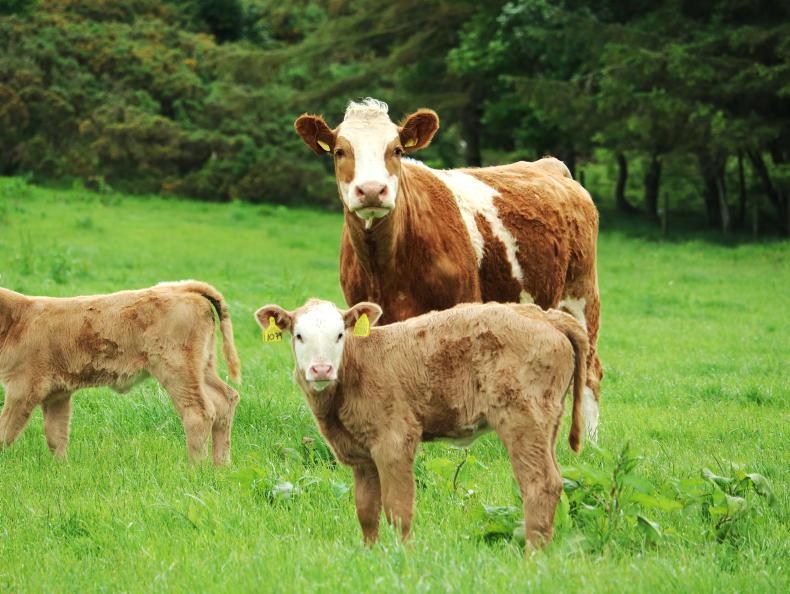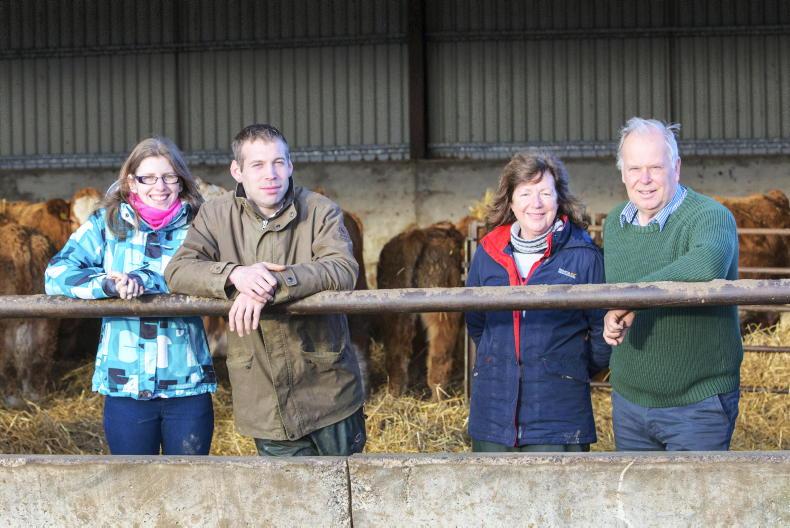On many farms, calving pattern can drift over the course of a few years and while the bulk of the cows calve in an eight- to 10-week period, total calving can take place over 52 weeks.
This leads to greater disease pressure in calving areas, greater management time required for treatments and a general drag on gross margin.
Across the focus farms, calving patterns were shortened, with the greatest coming from 42 weeks to 20 weeks, with a long-term target of 12 weeks. This has simplified management and led to greater calf survival.
The Mackays
Greenvale, Caithness
Mark and Shona calve around 180 cows in two batches in spring and summer. Over the programme they have continued to tighten up their calving period.
The daily liveweight gain for their calves in 2019 was between 1.07kg/day and 1.42kg/day.
Strong, growing calves all performed well over summer but when it came to housing and weaning, the first-born calves were 350kg compared to 180kg for calves born in the last week of calving, which is a difference of 165kg.
This spread was within a tight calving period of 12 weeks. Within the first eight weeks, there was a spread of only 66kg. This means that the calves born in the last month of calving would ideally be housed separately from the bigger, older calves for winter.
The Duguid family run 170 cows at their Aberdeenshire farm, near Huntly. Through the programme, the family made a concerted effort to reduce the calving spread.
At the start of the programme, they had calves born in 10 months of the year. However, by the end of the programme, this had been trimmed back to three months of spring-calving and three months of autumn-calving.

The Duguids have seen more even batches of calves thanks to tightening the calving spread.
The big benefit of the change was rationalising workload. This allows greater attention to detail on groups of cows which, in turn, reduces calf losses.
It has also allowed the farm to produce more even batches of store cattle for the mart at 14 months of age. The even batches are all of a similar weight with very few stragglers to be sold, which has increased the value of their cattle in the ring.
The Biffens
Arnage, Ellon
The Biffens were determined over the programme to reduce the calving spread and increase productivity in the herd.
At the start of the programme, one-third of the cows were over 10 years old, with calves born in 42 weeks of the year.
There was also a replacement rate of around 3%, so there was scope to tighten the calving spread and increase the proportion of young and more efficient cows in the herd.
Replacement rate
Over the programme, the replacement rate within the herd rose to 17%, with up to 25 heifers joining the herd.
This allowed older cows with later scanning dates to be culled out and the calving spread to be reduced from 20 to 14 weeks as they move towards a 10-week calving.
Adviser comment
Delaying putting in the bulls after a cold turnout
With snow at the start of May across much of Scotland and frosts continuing through the month, turnout has been delayed on many Scottish farms.
This is having a knock-on effect on bulling as many farmers are choosing to delay putting the bull out until a couple of weeks after the cows have hit the grass.
This means that many bulls won’t be with cows until closer to the end of May.
Many are questioning whether this is too late. However, if bulling starts on 28 May, then calving should begin around 6 March the following year.
This is a better time to calve as grass growth does not really start until March.
Matching calving date with grass growth leads to higher levels of productivity from a much cheaper feed source.
It is also another means of tightening the calving period.
Rather than trying to pull late cows forward, it is simpler to move bulling back by two weeks. For those currently starting calving in February, this is not a problem.
However, be mindful that if the bulk of the calving was already in April and May, then it might get a little late delaying a further two weeks.
On many farms, calving pattern can drift over the course of a few years and while the bulk of the cows calve in an eight- to 10-week period, total calving can take place over 52 weeks.
This leads to greater disease pressure in calving areas, greater management time required for treatments and a general drag on gross margin.
Across the focus farms, calving patterns were shortened, with the greatest coming from 42 weeks to 20 weeks, with a long-term target of 12 weeks. This has simplified management and led to greater calf survival.
The Mackays
Greenvale, Caithness
Mark and Shona calve around 180 cows in two batches in spring and summer. Over the programme they have continued to tighten up their calving period.
The daily liveweight gain for their calves in 2019 was between 1.07kg/day and 1.42kg/day.
Strong, growing calves all performed well over summer but when it came to housing and weaning, the first-born calves were 350kg compared to 180kg for calves born in the last week of calving, which is a difference of 165kg.
This spread was within a tight calving period of 12 weeks. Within the first eight weeks, there was a spread of only 66kg. This means that the calves born in the last month of calving would ideally be housed separately from the bigger, older calves for winter.
The Duguid family run 170 cows at their Aberdeenshire farm, near Huntly. Through the programme, the family made a concerted effort to reduce the calving spread.
At the start of the programme, they had calves born in 10 months of the year. However, by the end of the programme, this had been trimmed back to three months of spring-calving and three months of autumn-calving.

The Duguids have seen more even batches of calves thanks to tightening the calving spread.
The big benefit of the change was rationalising workload. This allows greater attention to detail on groups of cows which, in turn, reduces calf losses.
It has also allowed the farm to produce more even batches of store cattle for the mart at 14 months of age. The even batches are all of a similar weight with very few stragglers to be sold, which has increased the value of their cattle in the ring.
The Biffens
Arnage, Ellon
The Biffens were determined over the programme to reduce the calving spread and increase productivity in the herd.
At the start of the programme, one-third of the cows were over 10 years old, with calves born in 42 weeks of the year.
There was also a replacement rate of around 3%, so there was scope to tighten the calving spread and increase the proportion of young and more efficient cows in the herd.
Replacement rate
Over the programme, the replacement rate within the herd rose to 17%, with up to 25 heifers joining the herd.
This allowed older cows with later scanning dates to be culled out and the calving spread to be reduced from 20 to 14 weeks as they move towards a 10-week calving.
Adviser comment
Delaying putting in the bulls after a cold turnout
With snow at the start of May across much of Scotland and frosts continuing through the month, turnout has been delayed on many Scottish farms.
This is having a knock-on effect on bulling as many farmers are choosing to delay putting the bull out until a couple of weeks after the cows have hit the grass.
This means that many bulls won’t be with cows until closer to the end of May.
Many are questioning whether this is too late. However, if bulling starts on 28 May, then calving should begin around 6 March the following year.
This is a better time to calve as grass growth does not really start until March.
Matching calving date with grass growth leads to higher levels of productivity from a much cheaper feed source.
It is also another means of tightening the calving period.
Rather than trying to pull late cows forward, it is simpler to move bulling back by two weeks. For those currently starting calving in February, this is not a problem.
However, be mindful that if the bulk of the calving was already in April and May, then it might get a little late delaying a further two weeks.







 This is a subscriber-only article
This is a subscriber-only article










SHARING OPTIONS: